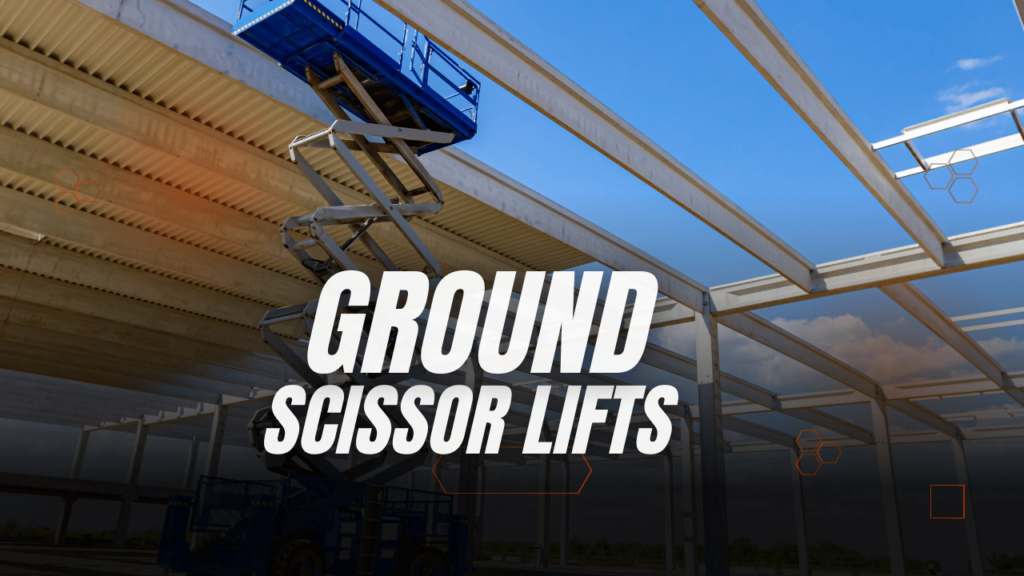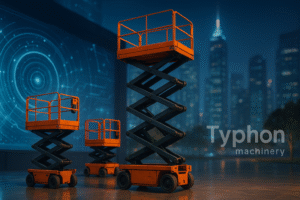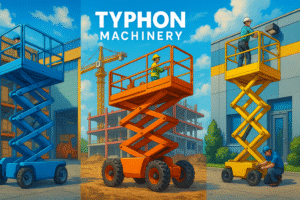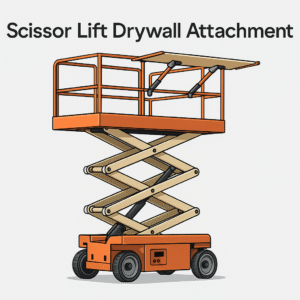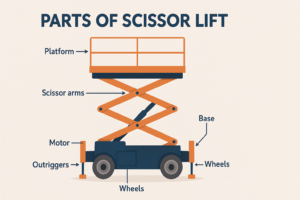Innovations in Uneven Ground Scissor Lifts
In the always evolving building and maintenance sector, scissor lifts are very vital. Because they provide secure, high access, they are employed in facilities and offices all throughout businesses. These flexible instruments help to install lighting systems and conduct building inspections, therefore enhancing safety and efficiency. Their efficiency is often evaluated considering difficult terrain.
Uneven terrain makes scissor lift operations useless and unsafe. Unstable traditional designs might cause equipment damage or mistakes. Creative ideas become even more crucial when builders face these obstacles. Modern scissor lifts with different bases and clever stabilization techniques help us to handle uneven terrain. Keep reading to see how these innovations are transforming the industry and ensuring everyone’s activities are safe.
The Demand for Creativity
Especially on uneven ground like building sites or during facility maintenance, working at heights may be dangerous. Conventional scissor lifts running over gravelly to highly sloping terrain increase the risk of slips, trips, and falls. Uneven terrain may cause workers to lose their balance and lifts to tip over. These qualities underline the requirement of creative answers in such demanding circumstances.
Scissor lifts meant for a level ground collapsed on slopes. On slopes or uneven ground, these gadgets might soon become unstable without complex stabilizing systems or flexible platforms. When experts in the field comment on uneven ground, manufacturers have to provide more dependable and safer scissor lift solutions. Industry leaders give solutions to these issues of top importance today.
Companies in building and facility management seek equipment able to operate securely on uneven ground. Safety experts want scissor lifts with smart sensors that vary stability to terrain and changeable bases. Uneven surfaces provide little obstacles that compromise worker safety and productivity; hence, stakeholders have to change their strategy to guarantee occupational efficiency and safety. Terrain and operations conditions differ; hence, it is essential to use contemporary technologies.
Base Personalization: Stability
By altering how scissor lifts perform on uneven ground, adjustable bases help alleviate a significant industrial problem. Creative bases provide mechanical or hydraulic adjustments to let the lift change easily on different surfaces. To level a platform on hills, slopes, and uneven terrain, legs may be stretched or retracted. This feature reduces tipping and instability, therefore improving efficiency and safety.
Modifying bases increases operator stability and trust. Knowing their lift helps users concentrate on completing tasks rather than stressing about shaky ground. Operating at height with confidence will help operators do difficult jobs requiring accuracy and safety. Changing foundation ratios based on topography helps to lower project delays and boost productivity without endangering safety.
Current Stabilization Techniques
Building tool designers change scissor lifts for uneven ground. In this industry, innovations in height and stability-stabilizing technologies are very vital. Operators have a strong foundation from dynamics and hydraulic technology that adjust with lift ascension. Monitoring real-time data helps these devices respond fast to changes in terrain or weight distribution, hence improving operational security.
There are various benefits from creative stabilizing mechanisms. They lower scissor lift tilt on uneven terrain. With additional load capacity and lateral stability, pilots may fly higher without sacrificing balance. The therapies have reduced site occurrences connected to lift instability. Following fleet upgrades, a major power supplier increased stable capacity while lowering safety risks by forty percent.
More user quotations highlight how these solutions increase worker confidence and operations. Consider an engineering company working on many difficult projects using scissor lifts. New stabilizer lifts, they said, made high-risk project staff safer. “Knowing our equipment fits how we use it helps us be more productive and focus on getting the job done safely,” said a corporate project manager.
Using modern stabilizing technologies increases project site safety and performance criteria for smarter construction. Scissor lifts are required in modern buildings and maintenance to raise worker efficiency and safety.
Smart Sensors increase Degrees of safety.
Clever sensor technology has changed scissor lifts over uneven ground as equipment technology develops. Real-time ground condition monitoring from these robust sensors enables operators to changeover tools. Track surface stability under lift via use of pressure gauges, tilt sensors, and accelerometers. By being proactive, hidden hazards are revealed and worker safety is improved.
Intelligent lift reduces the danger of accidents, mostly by use of sensors. These sensors might stop the lift until safe conditions are restored when they identify a significant slope or unstable ground. By removing guessing from demanding tasks, this degree of automated involvement lowers human error and hence guarantees industry safety standards compliance, thereby empowering personnel.
Future smart sensor scissor lift choices are many. Depending on the state of the work environment, machine learning might alter these lifts. Depending on historical performance on different terrain, lifts may advise adjustments or maintenance. IoT-enabled technologies link buildings; thus, remote monitoring solutions may let managers swiftly analyze sensor data, thus enhancing worker safety and decision-making.
As builders search for safer and more consistent solutions for uneven surfaces, smart sensor technology meets current needs and provides the basis for future improvements. Improved detecting abilities and integrated operating controls allow scissor lift safety under demanding environments.
Remote diagnostics and monitoring
IoT has tremendously enhanced high-terrain scissor lifts. Real-time IoT data sharing provides building teams with unheard-of access. Users may remotely check scissor lift load capacity, battery life, and stability on challenging terrain. This improves projections of repairs and increases efficiency.
Early issue solving reduces risk and downtime. Remote diagnostics notify maintenance on significant equipment failures. Should a sensor find a stabilizer malfunction on uneven ground, technicians may be notified immediately. Early on, corrections of issues without an onsite inspection improve worker safety and productivity.
Property managers could monitor numerous houses remotely. Many scissor lifts might be centrally operated for maintenance or rotation independently of human interaction. Thanks to IoT, one large leasing firm responded thirty percent quicker. Remote diagnostics assist to improve scissor lift performance and safety for demanding clients.
Reliable solutions become more important, hence creative technology like remote monitoring will always affect how professionals use scissor lifts on uneven terrain. These advances ensure equipment runs in the fast-paced construction environment of today and improve safety.
Customer Correction and Training
Training is key as scissor lift technology develops. Moving bases for uneven ground and smart sensor technologies complicate machine operation. Good training guarantees operators grasp and appreciation of the efficiency and safety advantages of these developments. Well-trained workers minimizes accidents and optimizes output on building sites with challenging topographies.
If companies want to properly integrate new technology into staff operations, they should use a diversified training strategy. They may provide staff members workshops where they could try the most recent scissor lifts. This method inspires operators’ inventiveness and raises their confidence on different grounds. Digital technologies might improve traditional training and fit worker learning patterns. Two instances here are simulations and instructive movies.
Keeping digital skills calls for constant learning. Manufacturer product changes demand constant staff development. Companies could provide e-learning tools like bite-sized scissor lift technology updates or refresher courses. This promotes a safety and adaptability culture that helps the company as well as consumers of remote monitoring.
Use a feedback loop to evaluate training effectiveness. As you explain recommended practices for newly connected devices, ask operators what worked and didn’t work in their learning experiences to guide next teaching sessions. By helping operators negotiate difficult terrain and enhance their abilities, user training increases safety at all work sites.
Scissor Lifts’ Future on Unlevel Ground
Working on uneven ground with a scissor lift calls for certain construction and maintenance gear. One trend guiding these gadgets is artificial intelligence/machine learning integration. Predictive analytics helps scissor lifts evaluate environmental conditions like ground stability and slope changes prior to usage to enhance performance. Equipment is operated as intended, therefore enhancing operational efficiency and safety.
Sustainable activities are expanding as companies give environmental effects first priority. Future scissor lift designs will include lightweight metals or recyclable polymers to lower carbon footprints without sacrificing strength. Energy-efficient engines and battery systems for long running hours with minimum charge intervals let manufacturers let operators run without downtime over demanding terrain.
Engineers and environmentalists would give biodegradable hydraulic fluids or solar-powered substitutes first priority in order to upgrade heavy equipment. These developments help regulatory constraints and a conscious market by allowing scissor lifts comply with environmental criteria and negotiate challenging terrain.
Technological developments will raise scissor lift performance under demanding conditions. Environmental projects and smart technologies will let these machines rapidly adapt to future industry requirements and satisfy present demand. Professionals negotiating challenging terrain have to adjust with the times to be effective and safe.
At last: Embracing a Scissor lift on Uneven Grounds
Safety on uneven terrain mostly relies on improvements in scissor lift. New stabilizing systems, smart sensing technologies, and flexible platforms help to boost operator stability and confidence. These advances allow construction professionals to function under less stress and reduce dangers.
As the industry grows, safety managers, equipment rental companies, and engineers have to be technologically current. Teams that abide by these principles might choose safer and more efficient approaches to working. Let us be ready for the definite future of scissor lifts on uneven terrain.

